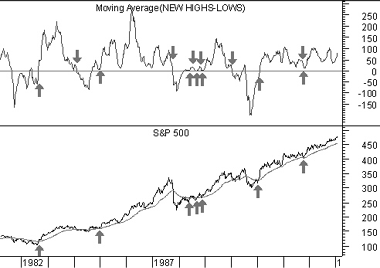|
NEW HIGHS-NEW LOWS
Overview
The New Highs-New Lows indicator ("NH-NL") displays the daily difference between the number
of stocks reaching new 52-week highs and the number of stocks reaching new 52-week lows.
Interpretation
You can interpret the NH-NL indicator as a divergence indicator or as an oscillator. I
usually plot a 10-day moving average of the NH-NL indicator to smooth the daily values.
Divergence
The NH-NL indicator generally reaches its extreme lows slightly before a major market
bottom. As the market then turns up from the major bottom, the indicator jumps up
rapidly. During this period, many new stocks are making new highs because it's easy to
make a new high when prices have been depressed for a long time.
As the cycle matures, a divergence often occurs as fewer and fewer stocks are making new
highs (the indicator falls), yet the market indices continue to reach new highs. This is a
classic bearish divergence that indicates that the current upward trend is weak and may
reverse.
Oscillator
The NH-NL indicator oscillates around zero. If the indicator is positive, the bulls are
in control. If it is negative, the bears are in control. You can trade the NH-NL
indicator by buying and selling as the indicators passes through zero. This won't always
keep you on the right side of the market, but it is helpful to confirm the current
trend.
Example
The following chart shows the S&P 500 and a
10-day moving average of the NH-NL indicator.
 I used the NH-NL indicator to confirm a traditional moving average trading system. I drew
"buy" arrows when the S&P 500 rose above its 50-day moving average, but only if the 10-day
moving average of the NH-NL indicator was above zero. I drew "sell" arrows anytime the
S&P 500 fell below its moving average.
I used the NH-NL indicator to confirm a traditional moving average trading system. I drew
"buy" arrows when the S&P 500 rose above its 50-day moving average, but only if the 10-day
moving average of the NH-NL indicator was above zero. I drew "sell" arrows anytime the
S&P 500 fell below its moving average.
By ignoring buy signals unless the 10-day moving average of the NH-NL indicator was
above zero, I reduced the number of trades by 50% and increased profits by 9%.
Calculation
The New Highs-New Lows is calculated by simply taking the difference between the number of
stocks that made new 52-week highs and the number of
stocks that made new 52-week lows. I
usually plot a 10-day moving average of this value.
|

